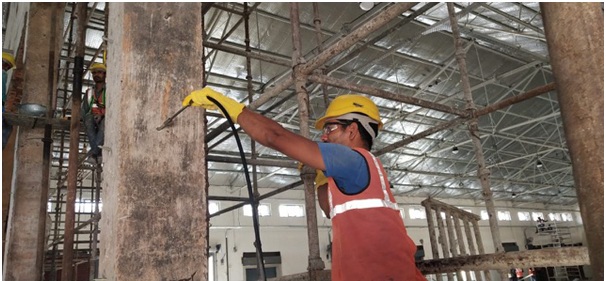Injection grouting is the method of filling the cracks, open joints, voids, or honeycombs, in concrete or masonry structural members. This is done under pressure with a grout material that cures in place to produce the desired results like strengthening a structure and preventing water ingress. Grout is a flowable plastic material and should have negligible shrinkage to fill the gap or voids and should remain stable without cracking, delamination, or crumbling. There are different types of grouts used for the repair and strengthening of concrete and masonry structural members. The selection of the type of grout for the particular type of concrete or masonry repair work should be based on the compatibility of the grout with the original material.
Different types of Injection Grouting

There are five types of injection grouting used in structures, each of them is explained below.
Polymer Injection Grouting
Polymer injection grouting is done with polymers like polyester epoxy, vinyl ester, polyurethane, and acrylic resins. The polymer is a widely used epoxy grout. The polymer injection grouting is available as grout materials such as liquid resin content, curing agent and aggregate. These types of injection grouting are suitable for concrete repairing work. The polymer injection grouts can be made suitable for repair works by adding modifiers to basic resins and curing agents to achieve the desired properties. There are three types of polymer-based injection grouting available.
Epoxy-Based Injection Grouting – it is non-shrinkable, effective in sealing the cracks, and has good bonding with every construction material. It is non-resistant to ultraviolet exposure and high temperatures.
Acrylic Polymer Based Injection Grouting – it comes with tensile properties and also resistant to cracking, segregation, and imperviousness. It is chemical-resistant and rapid setting.
Lignosulfonate Based Injection Grouting – it helps to compensate for drying and plastic shrinkage.
Fiber-Reinforced Injection Grouting
Fibers such as polypropylene, steel, or glass fibers are generally used for Portland cement to repair and strengthen the structural members. Fiber-reinforced injection grouting is resistant to impact and offers good flexural strength and ductility. Its application includes repairing the concrete structures as well as masonry structural members. This type of injection grout requires expertise skills to avoid the segregation of fibers.
Gas-forming Injection Grouting
Gas-forming injection grouting works on the principle that the gas bubbles expand the grout to compensate for shrinkage of grout after its application. These types of gas Bubbles will develop ingredients with the cement slurry. It requires correct confinement to develop good strength and volume stability. The reaction forming the gas bubbles is very fast and it will complete before placing the grout. This type of grouting is very sensitive to temperature so that it cannot be used for the places where the temperature is very high.
Cement-Sand Injection Grouting
The cement, sand grouting method required a higher amount of water and cement content. The use of cement sand grouting will result in shrinkage and cracking of grouting at the hardening stage. It is very easy to use and readily available in the market and used where strength enhancement of the structures is not essential. It is applied for the repair of concrete and masonry structures.
Sulfo-aluminate Injection Grouting
Sulfo-aluminate Injection Grouting works on the principle of shrinkage compensation. In these types of grouting, the shrinkage compensating cement or anhydrous Sulfo-aluminate expensive additives are used. This helps to produce expansion after the grout has set. The expansion of such grouts requires post-hardening curing and it will not be effective if moist curing is not available.
Process of injection grouting
The process of injection grouting involves various steps and each of them should be executed correctly with expert supervision. The complete process stepwise is given below.
Step 1- Drill the Ports on the Surface
Drill the holes or ports in the cracks at a regular interval. The distance between the two ports depends upon the types of cracks. The minimum diameter and depth of ports are 2.5cm and 5cm, respectively. For fine cracks, the distance between two ports ranges from 150 mm to 200 mm and the distance between ports in major cracks ranges between 300-400 mm. The spacing of ports is usually kept greater than the desired depth of grout penetration.
Step 2- Seal Cracks Between Ports
The crack between the ports should be filled with epoxy, polyester or cementitious materials. Give time to the seal to be hardened. If cracks pass through the structure, such as a wall, the surface seals and ports are applied on both sides.
Step 3- Clean Ports and Cracks
Before starting grouting it is very important to clean and flush the cracks and holes properly. This can be done manually with clean water by using a vacuum to clean the cracks. The cracks should besprinkle with water. It is very essential to clean it properly to establish a strong bond. Double-check the surface sealing and port system.
Step 4- Grouting the Hose Connection
For smaller grout pressure up to 350 kPa, a hand-held, cone-shaped fitting on the grout hose is sufficient. For larger grout pressures, short pipe nipples are connected into the holes to obtain grout hose connections. Fix the nipple or pipe in the holes and seal it with adhesive around such that it cannot move from its place.
Step 5- Injection Grouting on the cracks
Inject the grout material in the crack with the Grouting machine. It should be filled with pressure. Injection grouting required skilled labour. Consider the temperature on the site while processing.
Applications of Injection Grouting

It is used for repairing the cracks and strengthening the damaged or deteriorated structures. Its application includes;
- Reduce or fill the cracks or voids in the structural members
- Repairing the cracks in walls columns and other structural members
- Providing finishing to the wall
- Settlement of foundation
- Repairing the damage in the structural or masonry members
- For the honeycombing
- Making walls waterproof
- Avoiding seepage of water in stone masonries
- Strengthening tunnel linings

